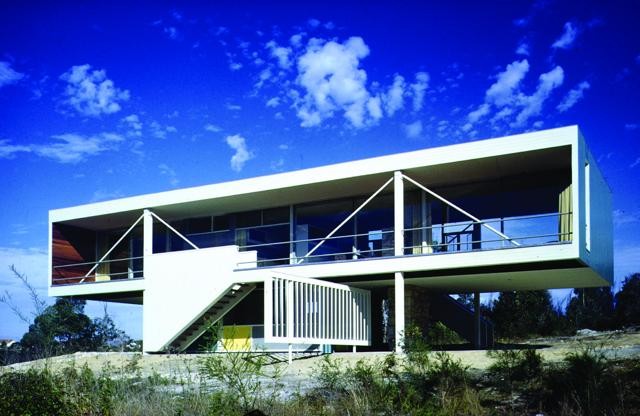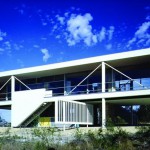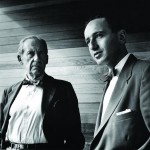- The Julian Rose House, design/completion 1949-1950, Wahroonga, Sydney, Australia. Steel structure, timber infill. Photo courtesy BMCM + AC
- Walter Gropius, left, and Harry Seidler. Gropius was the founder of the Bauhaus School and a huge influence on Seidler.
It’s likely that you haven’t heard of Harry Seidler. That is, unless you’ve studied Australian architecture and the history of the Bauhaus-turned-Harvard/Yale faculty. Seidler was also among the waves of artists and architects that made the pilgrimage to Black Mountain College to study with Josef Albers.
Harry Seidler: Architecture, Art and Collaborative Design, a new exhibition at the Black Mountain College Museum + Arts Center, takes an evolutionary approach to explaining Seidler, his work and the artistic collaborations that shaped them.
This exhibition is something of a living document, featuring a collection of photographs, notes, books, models, films, newspaper clippings, sketches and correspondences that build a long-term view of Seidler’s work and development. Rather than narrowing its focus by jumping through the years, as in a typical retrospective, it moves from person to person, cycling through decades of collaborations.
Those parcels and pictures create a collaborative web between Seidler and, among others, Bauhaus founder Walter Gropius, Marcel Breuer, Josef Albers, Pier Luigi Nervi, Max Dupain, Alexander Calder and Frank Stella. These artists, architects and thinkers proved most influential to Seidler’s personal and professional development, according to Vladimir Belogolovsky, the exhibition’s curator.
Many an exhibition includes such material — a letter here, and picture or postcard there — stuck between paintings in an effort to “liven up” the show and add some bit of character to the artist. But here, the show focusses on smaller items that Belogolovsky organizes to illustrate Seidler’s architectural upbringing. The imagery, in effect, supports the reservoir of primary sources.
Seidler’s career was one spent purifying his architectural philosophy. “He wasn’t interested in the architectural revolution,” Belogolovsky tells Xpress. “He was about refining architecture.” Seidler’s ethic was quintessentially postmodern. With each artist and architect he encountered, studied or worked with, his own form changed. It might have meant an adjustment in material used, and the inclusion of a retaining wall in a property’s design. Or, in the case of his work with Albers, greater attention to the balance of geometrical shapes.
Belogolovsky also details the events that led him from central Europe to Australia.
Seidler was Austrian by birth, but is Australian by legacy. His family sought refuge in England after fleeing Nazi-controlled Austria. But in 1940, at the age of 18, he was detained and sent to Canada, where he and other “enemy aliens” were held in a British internment camp. It was there, through personal study and exposure to other detainees, that he was introduced to modern architecture, the Bauhaus movement and its key players.
Seidler left the internment camp in October 1941 to study at the University of Manitoba in Canada. After graduating, he went to Harvard where he studied under Gropius and Breuer. It was Gropius who would direct him to Black Mountain College, where he studied color theory and design under Albers in 1946.
He initially traveled to Australia in 1948 to build a home for his family, who had relocated when the war ended. Seidler used plans that he and his colleague Rolland Thompson drew up in 1947, which was originally designed for a Massachusetts locale. So he adjusted the layout to accommodate the land, which they hand-picked to mimic the initial design. He didn’t change the materials though, and ended up importing many of the supplies. Even the furniture was imported from New York, Belogolovsky says. Architecturally speaking, it was a near-disaster.
“For most architects the first work is like a manifesto,” Belogolovsky says, “and he, in a way, damaged his reputation with his very first work.” But despite the criticism from fellow architects, the work became a huge success. Commissions and design requests mounted. With this work, Seidler is credited with bringing modernist architecture to Australia.
Belogolovsky was first exposed to Seidler’s work and the subtly grandeur of his reputation in 2010 while giving a lecture on Spanish architecture in Sydney, Australia.
“I was struck by the quality, and why I had never heard of him. And I was struck by the quantity of his work in Sydney,” Belogolovksy said. “There are so many skyscrapers and buildings that you could call it Seidler City.”
It was there that he met Penelope Seidler, Harry’s widow, and struck up the idea to create a traveling exhibition. The exhibition has toured in Houston, Texas, and Eastern Europe thus far. Future stops include the University of Manitoba in Winnipeg, University of Virginia in Charlottesville and then Brazil. It will ultimately return to Sydney in 2014, where it will join a citywide celebration of the now-Australian architect.
Harry Seidler: Architecture, Art & Collaborative Design is on view at the Black Mountain College Museum and Arts Center at 56 Broadway. The show runs through Aug. 21 and is free to members and students and $3 for the general public.






Before you comment
The comments section is here to provide a platform for civil dialogue on the issues we face together as a local community. Xpress is committed to offering this platform for all voices, but when the tone of the discussion gets nasty or strays off topic, we believe many people choose not to participate. Xpress editors are determined to moderate comments to ensure a constructive interchange is maintained. All comments judged not to be in keeping with the spirit of civil discourse will be removed and repeat violators will be banned. See here for our terms of service. Thank you for being part of this effort to promote respectful discussion.